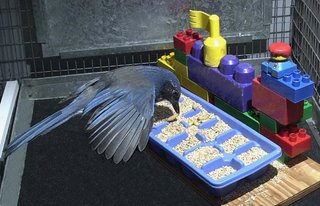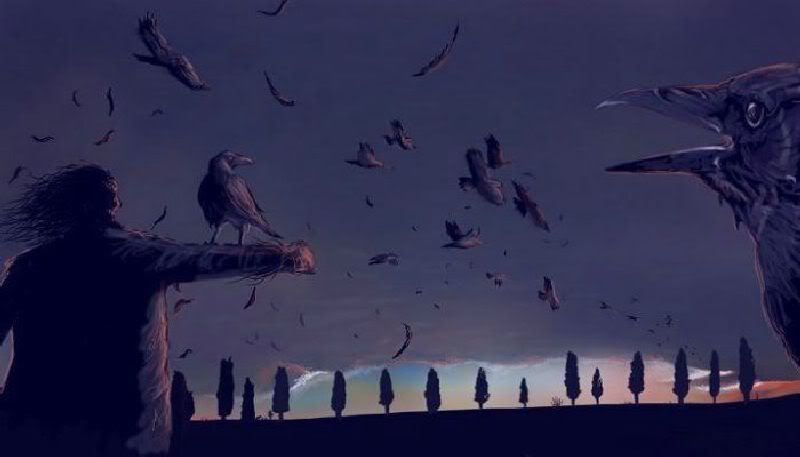(104) It takes a thief to know a thief
Scientists say scrub jays are not stuck in the present
Mental time-travel, the ability to use memories of past experiences and plan for the future, has traditionally been considered a quality unique to humans. Now scientists at the University of Cambridge have identified the same ability in a bird - the Western scrub jay, [a US native] similar to the British jay.
In a paper published this week in Nature magazine they describe laboratory tests which show that scrub jays who have experience of stealing food from other birds? hidden caches seem to use this knowledge when hiding their own supplies.
"To our knowledge this is the first experimental demonstration that a non-human animal shows elements of mental time-travel," says Prof. Nicky Clayton who conducted the research with her husband, Dr Nathan Emery.
Prof. Clayton first observed the behaviour during lunch hours spent in the grounds of the University of California, Davis. She noticed that there was fierce competition between scrub jays for lunch scraps left behind by students and staff. In order to protect their hard-won scraps the birds would hide their winnings, Prof. Clayton noticed that some scrub jays went even further - returning to re-bury the treasure when their rivals had left the scene.

Prof. Clayton and Dr Emery thought that such behaviour was probably intended to minimise pilfering by observers. They tested the hypothesis in a series of laboratory trials in which the birds were allowed to cache either in private, or while observed by another jay, and then Recover their caches in private.
One group was given the opportunity to steal other birds' hidden food caches: the other was not. The thieves re-hid their own food caches if they were observed when first hiding the food: the more innocent scrub jays, who had no experience of stealing from hidden caches, did not exhibit the same cunning.
These findings are a major development in the contentious field of animal cognition. Scientists have long debated whether animals demonstrate planning and conscious thought or an understanding that some events are in the past and some can guide how an individual should behave in the future.
This research also has implications for the 'theory of mind' - the ability to read another individual's intentions, beliefs and desires. In human infants this ability develops around the third year of life but it has yet to be demonstrated convincingly in animals.
"The re-caching behaviour of the experienced scrub jays and the projection of their own experience (pilfering) to the intentions of another bird demonstrates some of the hallmarks of theory of mind. Since re-caching is not dependent on the potential thief being present, the experienced jay must be using some cognitive ability to perform this behaviour; something only chimpanzees and other great apes have been suggested to do," suggests Dr Emery.
As mental time-travel is an essential part of 'theory of mind?, competitive caching may present a useful model to test further whether scrub jays can get into the mind of another bird.
For a long time the search for animal cognition concentrated on attempts to train animals, mainly primates, to reproduce human skills such as language. In the last few years there has been a paradigm shift - researchers are now more interested in studying the way animals behave in their own habitats. Clayton and Emery's findings would seem to vindicate those who have adopted the new approach.
Professor Uta Frith, University College London
"The beauty and originality of Clayton and Emery's work is that it has opened up ways of looking at the role of learning from experience in relation to innate behaviour patterns in complex social interactions. Birds are providing an imperfect but extremely revealing mirror to us. They let us see the behaviours we most treasure as part of being human in a new light".
Professor John Pearce, University of Cardiff and author of "Animal learning and cognition"
" The demonstration by Clayton and Emery that scrub jays are more likely to move food from one hiding place to another, if they were observed by other scrub jays when originally hiding the food, by itself is a remarkable finding. But to demonstrate that this effect depends upon the birds already having stolen food hidden by other scrub jays is quite extraordinary and has far- reaching theoretical implications. It suggests that scrub jays may possess sophisticated thought processes that allow them to anticipate and outwit the actions of other birds. If this is true, then scrub jays will be the only non-human species that can be said to possess a theory of mind.".
Notes for editors
1. Scrub jays are highly territorial - they hide food for future consumption, and rely on memory to recover these caches at a later date. But caching also has costs because these food stores can be found and taken by other birds. So in a competitive existence these birds need strategies to maximise their ability to recover the caches of other birds as well as their own, and counter strategies to prevent theft by pilfering competitors.
2. Nicky Clayton and Nathan Emery are a husband and wife research team. The publication of their Nature paper coincides with their joint birthday.
For further information please contact:
1. Prof. Nicky Clayton Tel: Email: nsc22@cam.ac.uk
2. Dr Nathan Emery Tel: Email: nje23@cam.ac.uk
3. Stuart Hogarth Tel: Email: sh339@cam.ac.uk
© Department of Experimental Psychology, University of Cambridge
Information provided by webmaster@psychol.cam.ac.uk
LINK
Mental time-travel, the ability to use memories of past experiences and plan for the future, has traditionally been considered a quality unique to humans. Now scientists at the University of Cambridge have identified the same ability in a bird - the Western scrub jay, [a US native] similar to the British jay.
In a paper published this week in Nature magazine they describe laboratory tests which show that scrub jays who have experience of stealing food from other birds? hidden caches seem to use this knowledge when hiding their own supplies.
"To our knowledge this is the first experimental demonstration that a non-human animal shows elements of mental time-travel," says Prof. Nicky Clayton who conducted the research with her husband, Dr Nathan Emery.
Prof. Clayton first observed the behaviour during lunch hours spent in the grounds of the University of California, Davis. She noticed that there was fierce competition between scrub jays for lunch scraps left behind by students and staff. In order to protect their hard-won scraps the birds would hide their winnings, Prof. Clayton noticed that some scrub jays went even further - returning to re-bury the treasure when their rivals had left the scene.

Prof. Clayton and Dr Emery thought that such behaviour was probably intended to minimise pilfering by observers. They tested the hypothesis in a series of laboratory trials in which the birds were allowed to cache either in private, or while observed by another jay, and then Recover their caches in private.
One group was given the opportunity to steal other birds' hidden food caches: the other was not. The thieves re-hid their own food caches if they were observed when first hiding the food: the more innocent scrub jays, who had no experience of stealing from hidden caches, did not exhibit the same cunning.
These findings are a major development in the contentious field of animal cognition. Scientists have long debated whether animals demonstrate planning and conscious thought or an understanding that some events are in the past and some can guide how an individual should behave in the future.
This research also has implications for the 'theory of mind' - the ability to read another individual's intentions, beliefs and desires. In human infants this ability develops around the third year of life but it has yet to be demonstrated convincingly in animals.
"The re-caching behaviour of the experienced scrub jays and the projection of their own experience (pilfering) to the intentions of another bird demonstrates some of the hallmarks of theory of mind. Since re-caching is not dependent on the potential thief being present, the experienced jay must be using some cognitive ability to perform this behaviour; something only chimpanzees and other great apes have been suggested to do," suggests Dr Emery.
As mental time-travel is an essential part of 'theory of mind?, competitive caching may present a useful model to test further whether scrub jays can get into the mind of another bird.
For a long time the search for animal cognition concentrated on attempts to train animals, mainly primates, to reproduce human skills such as language. In the last few years there has been a paradigm shift - researchers are now more interested in studying the way animals behave in their own habitats. Clayton and Emery's findings would seem to vindicate those who have adopted the new approach.
Professor Uta Frith, University College London
"The beauty and originality of Clayton and Emery's work is that it has opened up ways of looking at the role of learning from experience in relation to innate behaviour patterns in complex social interactions. Birds are providing an imperfect but extremely revealing mirror to us. They let us see the behaviours we most treasure as part of being human in a new light".
Professor John Pearce, University of Cardiff and author of "Animal learning and cognition"
" The demonstration by Clayton and Emery that scrub jays are more likely to move food from one hiding place to another, if they were observed by other scrub jays when originally hiding the food, by itself is a remarkable finding. But to demonstrate that this effect depends upon the birds already having stolen food hidden by other scrub jays is quite extraordinary and has far- reaching theoretical implications. It suggests that scrub jays may possess sophisticated thought processes that allow them to anticipate and outwit the actions of other birds. If this is true, then scrub jays will be the only non-human species that can be said to possess a theory of mind.".
Notes for editors
1. Scrub jays are highly territorial - they hide food for future consumption, and rely on memory to recover these caches at a later date. But caching also has costs because these food stores can be found and taken by other birds. So in a competitive existence these birds need strategies to maximise their ability to recover the caches of other birds as well as their own, and counter strategies to prevent theft by pilfering competitors.
2. Nicky Clayton and Nathan Emery are a husband and wife research team. The publication of their Nature paper coincides with their joint birthday.
For further information please contact:
1. Prof. Nicky Clayton Tel: Email: nsc22@cam.ac.uk
2. Dr Nathan Emery Tel: Email: nje23@cam.ac.uk
3. Stuart Hogarth Tel: Email: sh339@cam.ac.uk
© Department of Experimental Psychology, University of Cambridge
Information provided by webmaster@psychol.cam.ac.uk
LINK

![[Go to Site Index]](http://i6.photobucket.com/albums/y225/Abramelinn/Banner_Crow4.jpg)

<< Home